How AWS Inspector Drives Business Efficiency by Simplifying Cloud Security Management
Introduction
Amazon Inspector is a service that scans AWS workloads for vulnerabilities and network exposure. It’s easy to set up across all accounts in your organization using the AWS Management Console. Once initiated, it automatically finds EC2 instances, container images in ECR, and Lambda functions, and assesses them for vulnerabilities.
The inspector assigns a risk score to each finding by considering factors like CVE (Common Vulnerability and Exploits) information, network access, and exploitability, helping prioritize critical vulnerabilities for quicker remediation. Findings are centralized in the Inspector console and sent to Security Hub and EventBridge for workflow automation. Container image vulnerabilities are also reported to ECR for remediation. Inspector enables comprehensive security and compliance for AWS environments, accessible to teams of any size.
Scenario
As part of our learning initiative and preparation for the AWS Gameday event, we initiated a proof of concept (POC) using AWS Inspector. This POC focused on understanding how to identify vulnerabilities within EC2 instances, a critical component for ensuring the security of our cloud environment.
The primary goal of the POC was to explore AWS Inspector’s capabilities to scan EC2 instances for potential security vulnerabilities. This is particularly relevant for Gameday, where security plays a vital role in maintaining system integrity and compliance.
Read More: AWS CodeGuru
Use case of AWS inspector
AWS Inspector is a security assessment service that helps you improve the security and compliance of your AWS resources. Here are some common use cases for AWS Inspector:
- Vulnerability Assessment: Inspector can automatically assess the security vulnerabilities of your EC2 instances and other resources within your AWS environment. It helps you identify common vulnerabilities and misconfigurations, such as outdated software versions or insecure settings.
- Security Compliance Auditing: Amazon Inspector can be used to audit your AWS resources against predefined security standards and best practices, such as CIS benchmarks or specific compliance frameworks like PCI DSS or HIPAA. It helps you ensure that your resources adhere to industry-specific security requirements.
- Continuous Monitoring: The Inspector provides continuous monitoring capabilities, allowing you to regularly assess the security posture of your AWS environment over time. It automatically schedules assessments and alerts you to any newly discovered vulnerabilities or deviations from security standards.
- Integration with DevOps Pipelines: Inspector integrates seamlessly with CI/CD pipelines and DevOps workflows, enabling you to incorporate security assessments into your automated deployment processes. This helps you identify and remediate security issues early in the development lifecycle.
- Prioritizing Remediation Efforts: Amazon Inspector provides detailed findings and prioritizes security issues based on their severity, helping you focus your remediation efforts on the most critical vulnerabilities first. This allows you to efficiently allocate resources and mitigate the highest-risk security threats.
- Comprehensive Reporting: Amazon Inspector generates detailed reports that summarize assessment findings, including actionable recommendations for improving security. These reports can be shared with stakeholders, auditors, or compliance teams to demonstrate compliance with security requirements and track remediation progress.
Features :
- Amazon Inspector is a thorough vulnerability management service for compute workloads. It covers resources like Amazon EC2, Lambda functions, and container workloads. It detects software vulnerabilities and unintended network exposure that could compromise workloads or lead to malicious activities like data theft.
- Easily onboard and integrate Amazon Inspector with AWS Organizations using a one-click setup. With a single step in the Inspector console or a simple API call, you can activate Inspector across multiple accounts. You can designate an Inspector Delegated Administrator (DA) account for your organization to effortlessly initiate and set up Inspector for all member accounts, and centralize all findings.
- Amazon Inspector automatically finds Amazon EC2 instances, Lambda functions, and container images in Amazon ECR. It quickly starts scanning for software vulnerabilities and unintended network issues. It keeps rescanning workloads whenever new vulnerabilities are identified or changes occur, such as installing new software on an EC2 instance.
- Amazon Inspector uses the AWS Systems Manager Agent (SSM Agent) to gather software inventory and configurations from your EC2 instances. This data is then used to evaluate workloads for vulnerabilities.
- Amazon Inspector now provides agentless vulnerability assessments for Amazon EC2 instances (in preview).
- Amazon Inspector allows you to suppress findings based on your defined criteria. You can create suppression rules to hide findings that your organization considers acceptable risks.
- Amazon Inspector assigns a detailed risk score to each finding by analyzing CVE data along with factors like network accessibility and exploitability. This prioritizes critical findings, highlighting vulnerable resources. You can see the score and factors influencing it in the Inspector Score tab of the Findings Details panel.
- Amazon Inspector automatically marks findings as “Closed” when it detects that vulnerabilities have been fixed or remediated, eliminating the need for manual action.
- Amazon Inspector offers a detailed, near-real-time view of your organization’s coverage, helping you identify any gaps. It shows metrics and specifics about accounts, as well as EC2 instances, ECR repositories, and container images currently being scanned. It also flags resources not being monitored and offers guidance on including them for better coverage.
- Amazon Inspector consolidates findings in its console, sends them to AWS Security Hub, and uses Amazon EventBridge to automate workflows like ticketing.
- Amazon Inspector scans custom code in Lambda functions for security issues like injection flAWS or weak encryption. When vulnerabilities are found, it offers detailed findings and suggests fixes. Using AI, it provides code patches for various vulnerabilities, making it easier to address issues. By fixing vulnerabilities in foundational layers, it enhances security for all Lambda functions.
- Amazon Inspector simplifies the management of software bill of materials (SBOM) exports. It allows you to effortlessly export a consolidated SBOM for all monitored resources to an Amazon S3 bucket in standard formats. You can then download the SBOM, run queries with Amazon Athena, or create dashboards with Amazon QuickSight to analyze trends and gain insights.
- Amazon Inspector seamlessly integrates with developer tools such as Jenkins and TeamCity to assess container images. This integration enables developers to evaluate their container images directly within their CI/CD workflows, enhancing security early in the software development process.
- Amazon Inspector now supports CIS Benchmarks from the Center for Internet Security. You can use Inspector to conduct assessments against CIS configuration benchmarks for EC2 instances across your AWS Organization. These assessments cover level 1 and 2 configuration checks for operating systems like Amazon Linux 2, Windows 2019, and Windows 2022.
Setting up Inspector
If you want to manage Amazon Inspector for multiple accounts within your organization through a centralized administrator account, you must assign a delegated administrator for Amazon Inspector
Step 1: Navigate to the AWS inspector console and Delegate the account you want to enable inspector. You can also manage from your root account where you want to enable AWS inspector from AWS organizations and select AWS account or simply add your account ID.
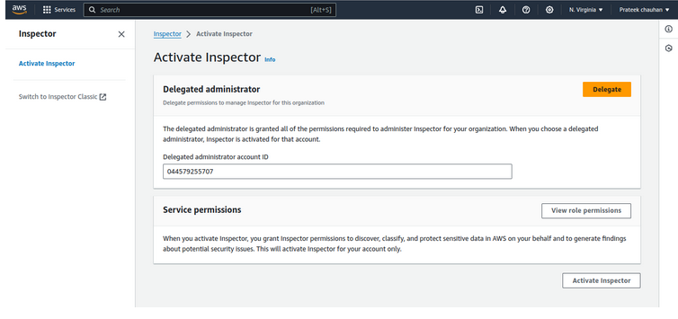
The delegated administrator must be a member of an AWS Organization. The delegated administrator needs the appropriate IAM permissions to manage AWS Inspector within the organization. Typically, you grant permissions like inspector: CreateAssessmentTarget, inspector: RunAssessment, and inspector: Describe*. Ensure that the delegated administrator account follows the principle of least privilege.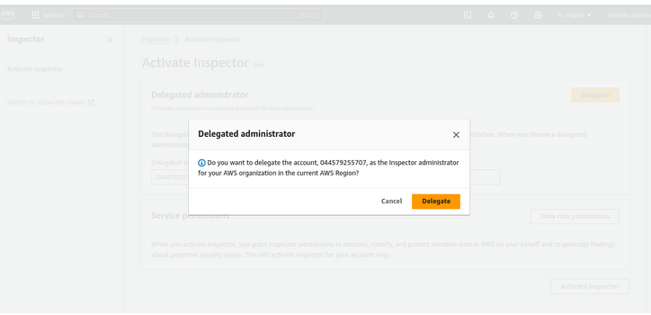
The delegated administrator can centrally manage security assessments, making it easier to maintain oversight and consistency across multiple accounts. The delegated administrator can access and view findings from all member accounts, streamlining vulnerability management and reporting.
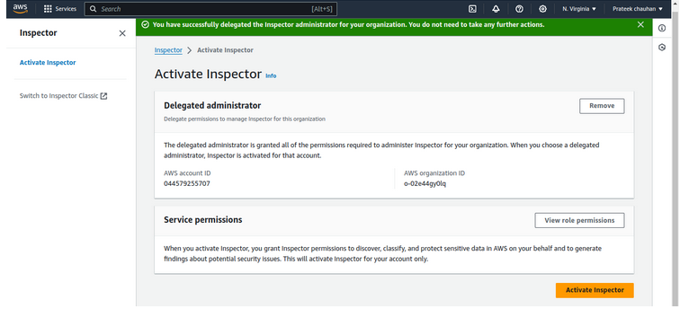
You can Enable Automatically activate Inspector for new member accounts and select so that if any new resources added it can scan it as well
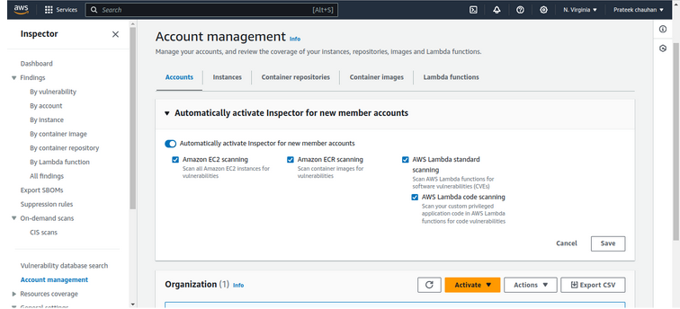
Step 2: Navigate to the AWS inspector dashboard, For Ec2 attach the SSM role or policy. You can see your findings in the Amazon Inspector console or via the API. They’re also sent to Amazon EventBridge and AWS Security Hub if enabled. Container image findings are additionally sent to Amazon ECR.
The Amazon Inspector console provides various ways to view your findings. The dashboard offers a summary of risks, while the Findings table shows detailed information about individual findings.
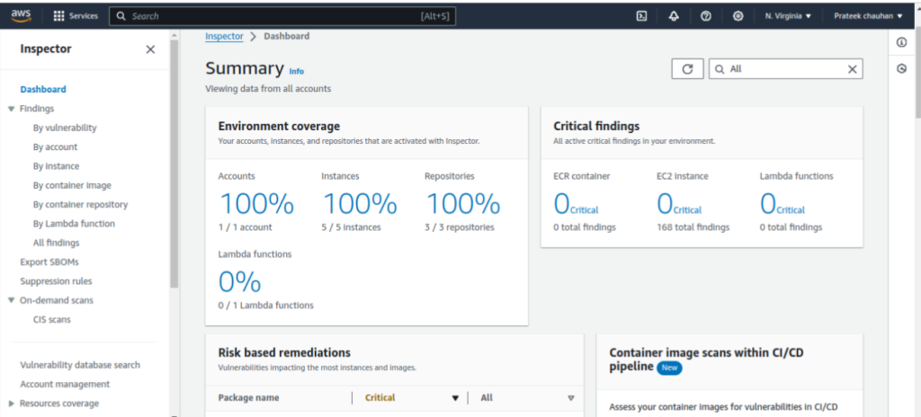
From the navigation pane, select Findings
By default, you’ll see the “All findings” tab, showing all findings for your EC2 instances, ECR container images, and AWS Lambda functions in your environment.
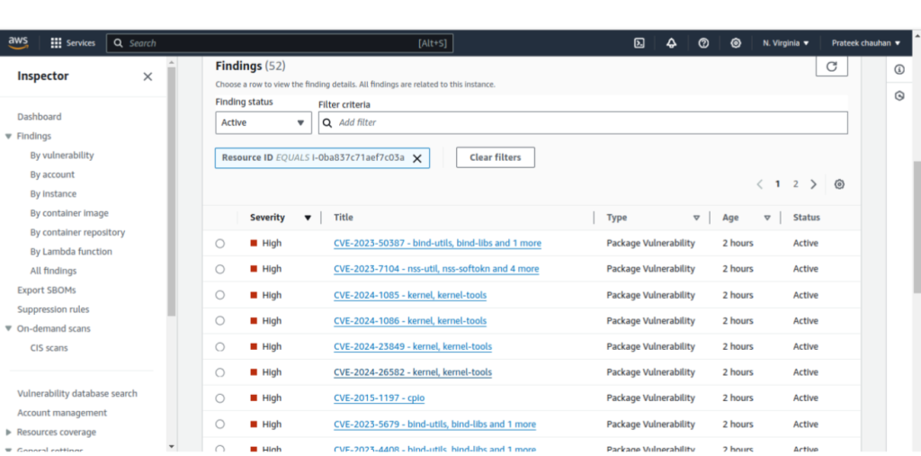
In the Findings list, click on a finding name to see more details. Every finding includes a “Finding details” tab.
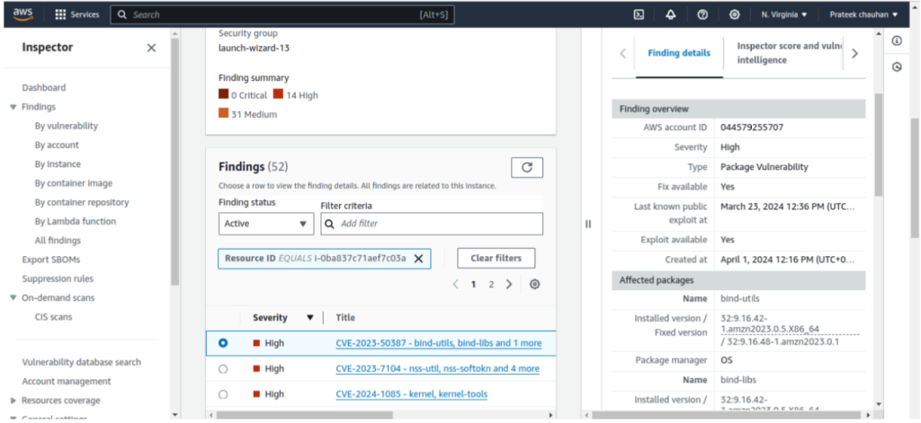
Package vulnerability findings include an “Inspector Score and vulnerability intelligence” tab. This tab explains how the Amazon Inspector score was calculated and provides details about associated Common Vulnerability and Exploits (CVE).
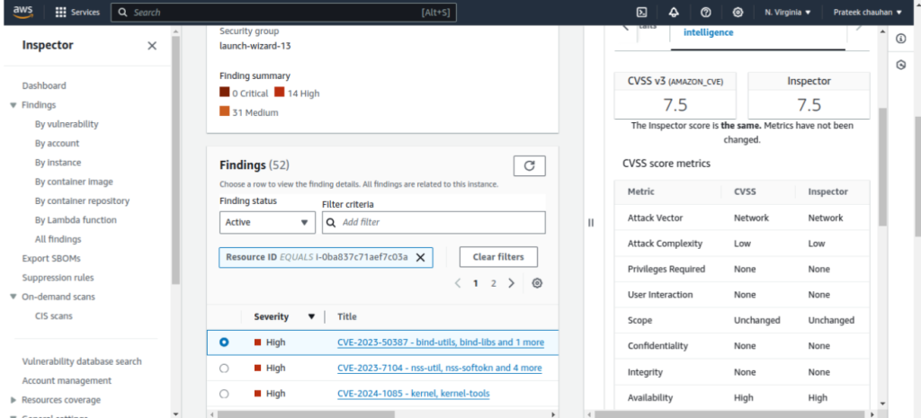
Summary
AWS Inspector is a comprehensive security assessment service that helps users improve the security and compliance of their AWS environments. It automatically assesses applications for vulnerabilities, compliance deviations, and potential security threats. Users can define custom security rules or use pre-built assessment templates to evaluate the security posture of their EC2 instances and applications. Amazon Inspector provides detailed findings with prioritized recommendations, enabling users to take proactive measures to mitigate risks. With its continuous monitoring capabilities, Inspector helps maintain security and compliance standards over time, ensuring the ongoing protection of AWS resources.



